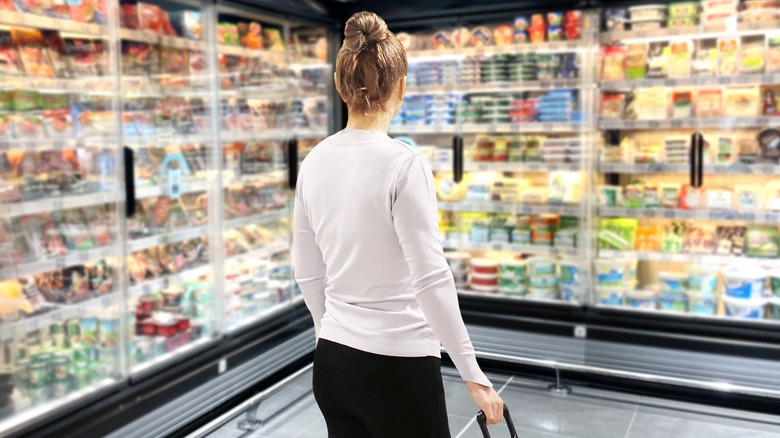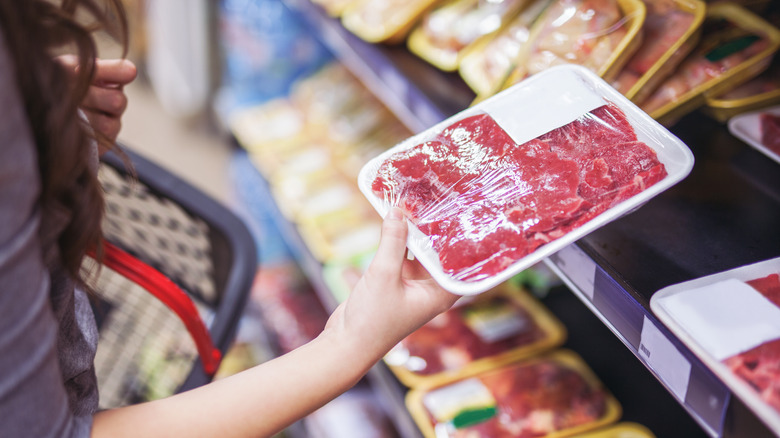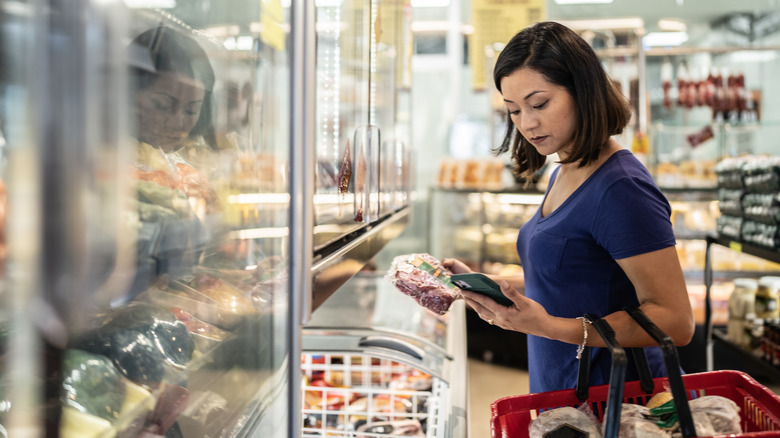The Last Groceries You Should Grab On Every Trip
In today's economy, smart shopping is essential for both saving money and reducing food waste. Having a grocery store strategy in place can save time and curtail overspending. Sticking to a plan ensures you buy the freshest, highest-quality foods and minimizes the risk of spoilage before you can even get them home.
You've probably heard the advice that it's best to shop the store's perimeter first, focusing on fresh, unprocessed foods in the produce, meat, and dairy sections located along the sides and back of the store. While that's not a bad idea, the problem is that it leaves the most perishable foods in your cart for an extended period of time. Meat and dairy items can begin to spoil quickly once removed from refrigeration, so it's best to grab those foods last.
The most effective way to navigate any grocery store trip is with a list. For maximum efficiency, group like items together on your list. For example, put all the baking items in one section, and do the same for snacks, canned goods, condiments, and so on. If you're familiar with the store's layout, you can even arrange your list by aisle to save extra time. Start by shopping for produce first, then proceed according to your list, picking up pantry staples and dry goods next. After that, go for non-food items like toilet paper and dish soap. Make the frozen, meat, and dairy sections your final stops.
The danger zone between safe and spoiled food
As soon as perishable foods leave a refrigerated environment, their temperature stars to rise, creating an ideal condition for bacteria to grow. According to USDA guidelines, meat, poultry, fish, and seafood may become unsafe to consume if exposed to room temperature for an extended period. When raw meat reaches the "Danger Zone," which the USDA classifies as ranging from 40 to 140 degrees Fahrenheit, bacteria can multiply rapidly. If food stays in the Danger Zone for two or more hours, it should be discarded — this time reduces to just one hour if the outside temperature exceeds 90 degrees Fahrenheit.
Given how quickly meat can spoil, the rest of your shopping should be completed before heading to the meat and seafood sections. Utilize your shopping list to target what you need efficiently; once you have raw meat in your cart, it's no longer time to dawdle.
The same Danger Zone principle also applies to perishables in the dairy section, including eggs, milk, yogurt, and soft cheeses. Note that butter, margarine, and hard cheeses like cheddar and Parmesan are less sensitive to temperature changes. By the time you reach the dairy aisle, the clock is ticking on how long those foods remain safe. Grab what you need and go. The same logic applies to cooked meats and prepared deli items requiring refrigeration; they should also be among the last items you pick up for the same reasons.
How to not lose your cool while grocery shopping
Most foods in the freezer aisle are frozen solid and take longer to thaw than refrigerated foods take to warm up. In general, you don't need to be concerned about how long frozen food will last while you're completing your meat and dairy shopping. Exceptions include quickly melting items like ice cream and popsicles; grab these last as you head toward the checkout lanes. Grouping frozen items together in your cart can also help keep them colder for longer.
Keep your cart organized as you shop to make bagging and unloading easier. Arrange your cart so that fruits and vegetables are together in one section, bottles and beverages in another, and heavier cans and boxes positioned so they won't crush other items. To prevent cross-contamination, place meat items separately, ideally wrapped in plastic bags to contain any raw juice — consider bagging your items yourself if the store allows it. Group items in the bags just as they were organized in your cart, taking care not to make any bag too heavy. This makes it quicker to put away perishables when you get home.
Shop like a pro and keep your food cold from store to door. Don't give perishables a chance to warm up. Consider bringing insulated bags with you and transferring perishables into them as soon as you return to your car. Once home, promptly refrigerate or freeze these items to ensure their safety and freshness.



